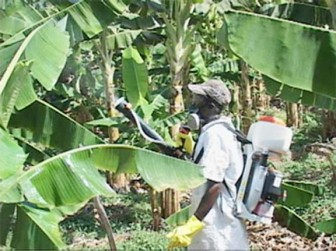While the spread of the leaf spot disease Black Sigatoka is being monitored by the authorities, its impact on other Caribbean territories has seen an increase in demand for plantains from the local market.
The Ministry of Agricul-ture (MoA) said recently that tests which were sent to the United Kingdom last year to determine the presence of the disease, have confirmed that it is present in local plantain and banana plants.
The National Agricultural Research and Extension Institute (NAREI) said recently via the Agriculture Minis-try that the results from the Centre for Advanced Biome-dical Imaging (CABI) in the UK stated that the disease is in fact Black Sigatoka. The disease is known to affect the musa type plants, those being plantains and bananas.

Farmers in the Parika area on the East Bank Esequibo, an area which had been hard hit by the disease continued to experience difficulties in coping with treatment of the disease. A farmer in the Hog Island area, who asked to remain anonymous, told this newspaper recently that he had been purchasing the fungicides which farmers had been advised by the Agricul-ture Ministry as being adequate to combat the disease. He said the fungicides have had some amount of impact but much more needed to be done including frequent visits by extension officers of the MoA.
The man said that another method which would see the containment of the disease was to clear the farming area which the disease has affected, but he noted that most of the farms at Hog Island were already affected and as such this method would have been at a disadvantage to most farmers.
According to NAREI, areas around the country which are affected by the disease include parts of Regions 1, 2, 3, 4, 7, 8,10 and to a lesser extent in isolated areas of Regions 5 and 6.
As regards what is being done to curtail the spread of the disease, the agency stated that through the MoA, NAREI’s Plant Health Quarantine unit measures the spread of the disease and it is being monitored to curtail its impact at ports of entry and exit.
The NAREI Musa Unit, which was set up to assist farmers, also has an aggressive public awareness programme which includes TV, radio, newspaper advertisements/ infomercials to sensitize farmers about the disease, the agency stated. Addition-ally, the unit has conducted numerous farmers’ training and demonstration activities across the country.
NAREI emphasized that the movement of infected material from disease areas to disease free area should be restricted in order to stem the spread of the disease.
NAREI said too that the disease has severely impacted the plantain industries of many other Caribbean countries and as a result, there is a “significant increase in demand for plantains from Guyana,” thus resulting in an increase in the Parika farm gate price and prices on the local market as well.
PNCR MP Mervyn Williams, who had been interacting in the Region 3 area with farmers whose farms have been affected by the disease, told this newspaper recently that the authorities should have nipped the spread of the disease in the bud when it was first identified some time in 2005. He said the Barima/Waini area was where the disease’s presence was first reported and according to him, Guyana would have been in a much more advantageous position in the regional plantain market had the authorities acted then.
He said it is common knowledge that in order to eliminate a disease the entire crop should be destroyed, by cutting down the plants and clearing the entire plant area, since the disease is an airborne one. He said that there were instances in the East Bank Essequibo area where farms “at point A,C and E were sprayed with fungicides or looked at by the extension officers”, while points B and D remained unassisted.
He said the recent passing of the plant protection legislation would also have implications for the industry since the transport of plant materials which are known to have contracted a disease could see the transporter of such items facing penalties.
In August 2009, the Minis-try of Agriculture, Animal Husbandry and Fisheries of Suriname requested the authorities at Nickerie to close down the illegal backtrack route crossing on the Corentyne River between the two countries, citing “widespread” destruction of the banana and plantain fields by the disease.
This newspaper was told that a Surinamese national was among a group of individuals who had carried out research here and may have informed the authorities in the neighbouring country of the situation. The route was subsequently reopened after local officials, led by Agriculture Minister Robert Persaud visited Suriname and held talks with their counterparts in that country.
The Black Sigatoka disease is a leaf spot disease affecting plantain and banana plants caused by an ascomycete fungus. Research shows that the leaves of plants damaged by the disease may have up to 50% lower yield of fruit. On commercial export plantations the disease is controlled by the frequent application of fungicides, while the removal of the affected leaves, good drainage, and sufficient spacing are measures which can be adopted to fight the disease.





